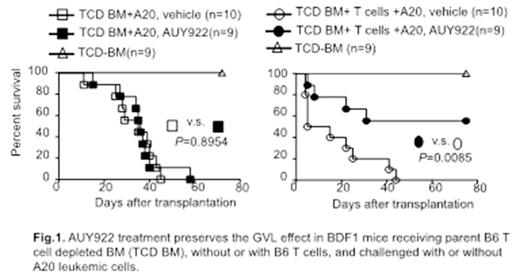Abstract
Graft-versus-host disease (GVHD) remains a major cause of morbidity and mortality after allogeneic hematopoietic stem cell transplantation (allo-HSCT). GVHD involves complex interactions of immune cells, induction of host-reactive donor effector T cells, and donor T cell-mediated injury to normal tissues. Epigenetic changes have been implicated in T cell-mediated GVHD. We previously described that genetic deletion of Ezh2, which catalyzes trimethylation of histone H3 at lysine 27 (H3K27me3), reduced GVHD in mice but preserved graft-versus-leukemia (GVL) responses. Several selective inhibitors of Ezh2 have been recently discovered (e.g. GSK126, UNC1999 and EPZ6438), which specifically reduce the levels of H3K27me3 but not EZH2 protein. Unexpectedly, our preliminary studies showed that administration of GSK126 failed to prevent GVHD in mice. This stands in contrast to our findings that genetic deletion of T cell Ezh2 leads to GVHD inhibition, and suggest that Ezh2 may regulate GVHD through a mechanism independent of H3K27me3. Identifying an optimal method to target T cell Ezh2 for controlling GVHD remains an unmet need.
Using experimental mouse models, we demonstrate that functional heat shock protein (Hsp)90 is critical for maintaining Ezh2 protein stability and function in activated T cells. Pharmacological inhibition of Hsp90 destablizes Ezh2 protein in alloreactive T cells, reduces GVHD but preserves GVL effects in mice. To determinethe molecule(s) that is critical for maintaining Ezh2 protein stablility in T cells, we performed mass spectrum (MS) analysis and identified 25 Ezh2-interacting proteins that showed higher intensities than others in T cell receptor (TCR)-activated CD8+ T cells. Among them, we found a group of proteins associated with protein folding and degradation, including Hsp90. Hsp90 is a molecular chaperone required for the stability and function of several key signaling intermediates (e.g., AKT, Raf1 and ERK1/2). Using reciprocal co-immunoprecipitation assay, we confirmed that Ezh2 and Hsp90 directly interacted with each other in TCR-activated CD8+ T cells. Pharmacological inhibition of Hsp90 using its specific inhibitor AUY922, which is currently in phase II clinical trials for cancer therapy, effectively reduced Ezh2 protein without decreasing H3K27me3 24 hours after treatment. This effect was accompanied by decreased proliferation and survival of TCR-activated T cells in vitro. Retroviral overexpression of Ezh2 in T cells markedly improved their proliferation in the presence of AUY922, suggesting that reducing Ezh2 by Hsp90 inhibition is an important mechanism that reduces proliferation and survival of activated CD8+ T cells. Building on these observations, we examined the impact of inhibiting Hsp90 on GVHD by administering AUY922 to B6 mice receiving MHC-identical minor histocompatibility antigen-mismatched C3H.SW mouse CD8+ T cells and T cell-depleted bone marrow (BM). While about 80% of control B6 recipients died from severe GVHD, 80% of AUY922-treated B6 recipients survived without clinical signs of severe GVHD by 84 days after transplantation. In vivo AUY922 administration reduced the survival and expansion of alloreactive T cells, and decreased the fequency of alloreactive T effector cells producing IFN-g and TNF-a. To rule out the model-specific effect of AUY922, we used a haplo-identical B6 into BDF1 mouse model of GVHD. Using CFSE-labeled donor T cells, we first validated that in vivo administration of AUY922 to unirradiated BDF1 mice receiving parent B6 T cells selectively reduced the expansion of alloantigen-reactive donor T cells, but did not impair the expansion and survival of donor T cells that did not respond to alloantigens. In lethally irradiated BDF1 mice receiving B6 T cells and BM, AUY922 administration reduces lethal GVHD, with approximately 50% of them surviving long-time. Importantly, AUY922 treatment preserved GVL activity of donor T cells, leading to significantly improved survival of BDF1 recipients challenged with A20 leukemic cells (Fig.1).
Taken together, our findings identified a previously unrecognized molecular mechanism by which Ezh2 and Hsp90 are integrated to regulate alloreactive T cell responses and GVHD. Targeting the Ezh2-Hsp90 complex using AUY922 represents a novel and clinically relevant approach to reduce GVHD while preserving GVL effects, thereby improving the efficacy of allo-HSCT.
No relevant conflicts of interest to declare.
Author notes
Asterisk with author names denotes non-ASH members.


